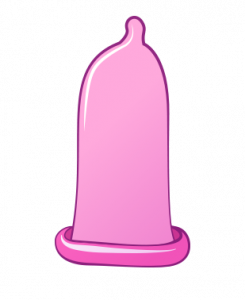Summary:
What is it? A latex or non-latex covering that fits over an erect penis before intercourse.
Effectiveness: approximately 82% effective in typical use (but can be more effective if used consistently and correctly).
Price: $0.50-$2 per condom
Other information: Use non-latex condoms for latex allergy or sensitivity. Use with water-based lubricant every time and right from the beginning of intercourse to be most effective. Protects against sexually transmitted infections.
If used perfectly, condoms can be up to 98% effective at preventing pregnancy. In reality they are only 82% effective – an average of 18 people out of 100 get pregnant when using condoms for a year. Condoms need to be used every time and from the very beginning of intercourse to most effectively prevent pregnancy. If you are only using condoms sometimes or on certain days of your cycle or if you start having intercourse and then put on a condom before ejaculation then you will be at higher risk of pregnancy. Condoms can also be used in combination with other contraceptive methods – such as the birth control pill, patch, ring or shot, or an IUD – to provide stronger protection against pregnancy.
Condoms need to be used every time and from the very beginning of intercourse to most effectively prevent pregnancy. If you are only using condoms sometimes or on certain days of your cycle or if you start having intercourse and then put on a condom before male ejaculation then you will be at higher risk of pregnancy. Condoms can also be used in combination with other contraceptive methods – such as the birth control pill, patch, ring or shot, or an IUD – to provide stronger protection against pregnancy. If you need strong protection or if you or your partner is not willing to use condoms every time you have sex then condoms on their own may not be the right choice for you.
Condoms protect against sexually transmitted infections (STIs) including Chlamydia, Gonorrhea and HIV. Other contraceptive methods do not prevent STIs.
What kind of condoms should you use?
- All brands of condoms are quality tested in Canada, so will be of high quality. However, sometimes condoms are novelty or joke items. Always look to see if the package says the condom will protect against pregnancy and sexually transmitted infections (STIs), including HIV.
- Male/external condoms are available in different sizes. Regular sized condoms will fit most people, but if condoms are breaking or slipping off regularly then you may need larger or smaller sized condoms. Sometimes this problem can be solved with more lubrication (see the section about “using a male/external condom” for more information).
- Most condoms are made of latex. Some people have latex allergies or sensitivities, so there are condoms made with different materials that you can try. The most common latex alternative is polyurethane (all female/internal condoms are made from polyurethane and some male/external ones are too). There are also some condoms made from animal skin – however, these only protect against pregnancy and not against STIs.
- External/male condoms are the most commonly used and are easier to get. They are also more effective at preventing pregnancy. However, female/internal condoms, provide stronger protection against STIs. They also allow women/receptive partners to have more control over condom use. They can even sometimes be used without a partner knowing, if negotiating condom use is difficult. They are also less likely to break and transfer heat better which for some people can increase sensation. However, they are slightly less effective, more expensive and can also sometimes make noise during intercourse.
Before using a condom:
- Get familiar with condoms ahead of time. It is best if the first time you see, touch or use a condom is before rather than during sex. Take a condom out of its package, get used to it, try putting it on yourself or on a vegetable or fruit. The more comfortable you are with condoms, the better chance you will be able to use them successfully.
- Condoms are most effective when both partners are familiar with them and how they are used.
- Communicate with your partner about birth control and condoms before, during and after sex. It is best to make sure you are on the same page about condom use and the amount of risk you are comfortable with ahead of time. It is also important that both of you know that a condom is being used and if it has broken or slipped off so that you can take extra precautions if needed (see the section on about if a condom breaks or slips off).
- Store condoms somewhere cool and dry. Heat and sunlight can damage condoms.
- Always check the expiry date before using a condom. If the expiry date has passed do not use the condom.
- “Pillow test” the condom – before opening it, fold and squeeze the package together into a U-shape. If air escapes and the package goes flat rather than pillowy when folded, then do not use it as there may be tears in the package.
- Open the package down the jagged edge and remove it gently. Using teeth or long nails can tear a condom.
- Look at the condom to make sure there is no discolouration or flakiness. If there is, throw it away.
- Think about whether you would like to use another form of birth control along with condoms
- Consider whether you would prefer to use male/external condoms (which this handout focuses on), or female/internal ones. Female/internal condoms go inside the vagina (or can be used anally as well) rather than on the penis.
Using a male/external condom:
- Use water-based lubricant (lube) to help condoms feel better and be less likely to break or slip off. Start with a lubricated condom and add more to the outside of the condom as well as a single drop in the tip before it is rolled on.
- Do not get oil-based products (ex. hand lotion, Vaseline, and lipstick or lip balm) on a condom or it may break.
- Put the condom onto the tip of the penis with the rolled up rim facing outward. If you put the condom on the wrong way, it will not roll down. If this happens, discard it because there might already be fluid on it (preejaculate or precum) that can get someone pregnant or give them an STI.
- Pinch the tip so that there is no air inside and room for the ejaculate (semen).
- Roll the condom down to the base of the penis.
- Spermicides can make condoms more effective at preventing pregnancy. Applying a spermicidal foam, film, gel or sponge close to the cervix (the opening of the uterus at the top of the vagina) is more effective than having spermicide on the actual condom. Always check the expiry date, read the instructions, and follow them closely.
- It can be good to check the condom during sex to make sure it is not breaking or slipping off.
This can be done regularly throughout intercourse, when shifting positions and/or if the sensation changes (i.e. you start having more or less feeling, the condom feels pulled tight or so on).
Removing and discarding a male/external condom:
- Withdraw the penis while it is still hard so there is less chance of fluids leaking and move away from the vagina before taking the condom off.
- Hold the condom while slowly pulling it off bit by bit, keeping the semen inside. Do not pull from the tip.
- Check the condom to see if it is broken. Observe whether fluids are leaking out or if it has any obvious tears.
- Throw the condom away in the garbage. Do not flush it down the toilet.
If a condom breaks or slips off:
- Discard condom (see above). Use a new condom if you are going to continue having intercourse.
- Emergency Pills: Back up with an emergency pill like Plan B or Ella. Plan B and other progestin emergency pills like Norlevo or Next Choice are about 50% effective and are available at pharmacies without a prescription. You can buy them in advance to have at home. They can be taken up to 5 days after sex, but the sooner you take them the more likely they are to work. Ella is available by prescription. It is more effective overall (about 60%) and does not lose effectiveness as quickly over time (but it is still best to use them as soon as possible). Emergency pills are usually $15-$40.
- Copper IUD: a Copper IUD is the most effective form of emergency birth control – it is over 99% effective at preventing a pregnancy if inserted any time within 7 days after unprotected sex. If you leave the IUD in, it will continue to provide very effective (over 99%) protection. If you do not like it or want to get pregnant, you can have it taken out any time after your next period.
- Reassess: if a condom breaks or slips off, it can be a good time to think about whether you want to do something differently with regards to birth control. Is there something you could do to make condoms work better for you? Do you need a more effective method of contraception or something to use in combination with condoms?
Questions? Contact the Sex Sense Line at 604-731-7308 (1-800-739-7367) or www.sexsense.org

